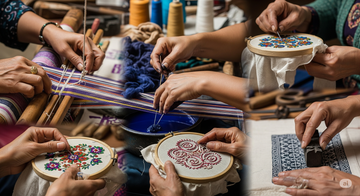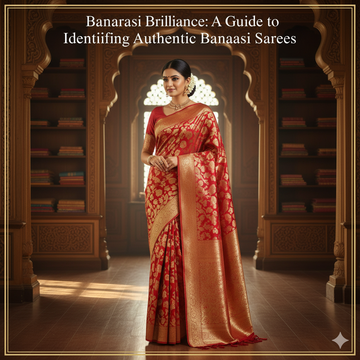The Hands Behind the Hues: Meeting Our Master Weavers and Artisans
by Joelpaes . on Aug 20, 2025

 India is a land woven together by threads of culture, heritage, and artistry. From Kashmir’s crisp Pashminas to Tamil Nadu’s lustrous Kanjivarams, the fabric of our country tells timeless artisan stories. Behind every intricate motif and every vibrant hue lies the patience, passion, and precision of Indian weavers who have carried forward centuries-old traditions with remarkable resilience. Their work embodies not just beauty but identity, linking generations through a legacy of handloom craftsmanship.
India is a land woven together by threads of culture, heritage, and artistry. From Kashmir’s crisp Pashminas to Tamil Nadu’s lustrous Kanjivarams, the fabric of our country tells timeless artisan stories. Behind every intricate motif and every vibrant hue lies the patience, passion, and precision of Indian weavers who have carried forward centuries-old traditions with remarkable resilience. Their work embodies not just beauty but identity, linking generations through a legacy of handloom craftsmanship.

A Legacy Stitched in Time
The history of weaving in India stretches back to the Indus Valley Civilization. Archaeological findings have revealed spindle whorls and fragments of cotton cloth, signifying that textile production was an integral part of life even then. Over centuries, India became synonymous with fine fabrics so much so that our muslins, silks, and cottons were sought across Europe, Africa, and Asia. Each dynasty that ruled our land from the Mughals to the Cholas nurtured the craft by supporting weaving societies and guilds, ensuring that authentic weaving practices flourished.
Indian weavers were not merely laborers but custodians of cultural identity. Their skill preservation ensured that every region developed its unique textile vocabulary. Banarasi brocades, Jamdani muslins, Ikats of Odisha and Telangana, and Kashmiri shawls each of these traditional Indian textiles narrates a story of its people, geography, and philosophy of life.

Premium Weaving Practices Across India
India’s handloom craftsmanship is celebrated worldwide for its diversity and technical finesse. Every region has a signature weave, developed in harmony with local resources and cultural narratives:
Banarasi Silk (Uttar Pradesh): Known for its gold and silver zari work, Banarasi silk sarees are often described as poetry in silk. They take weeks or even months to weave, with each motif reflecting Mughal influences of florals and jali work.
Kanchipuram Silk (Tamil Nadu): Lustrous, durable, and steeped in temple tradition, these sarees are famed for their contrasting borders and mythological motifs.
Pashmina (Kashmir): Soft and feather-light, Pashmina shawls are hand-spun from the wool of Changthangi goats. The art of weaving and embroidering these textiles requires unmatched delicacy.
Patola (Gujarat): Double ikat weaving of Patola is among the most intricate techniques in the world, involving precision dyeing and synchronization of warp and weft.
Jamdani (West Bengal): This muslin weave, with its delicate floral patterns, was once so fine that a six-yard saree could pass through a ring.
Phulkari (Punjab): Though primarily embroidery, Phulkari is interwoven with Punjab’s agrarian life and festivity, reflecting bold motifs and bright hues.
These premium weaving practices show how Indian weavers turn raw threads into living art forms that breathe heritage.
 Weaving Societies: The Heart of Collective Heritage
Weaving Societies: The Heart of Collective Heritage
The rise of weaving societies across India has played a crucial role in preserving traditional Indian textiles. From the All India Handloom Board to state-level cooperatives like Co-optex in Tamil Nadu and Boyanika in Odisha, these societies have offered both a platform and protection for artisans. They ensure fair wages, curb exploitation, and create awareness in urban markets about authentic weaving.
The Khadi and Village Industries Commission (KVIC) is perhaps the most iconic of them all, representing not just cloth but a philosophy of self-reliance that Mahatma Gandhi championed. Similarly, handloom clusters in Varanasi, Chanderi, Bhagalpur, and Pochampally thrive through government support and collective effort, safeguarding artisan stories from being lost to industrialized imitations.
 Cultural Identity Woven in Threads
Cultural Identity Woven in Threads
What makes Indian weaving extraordinary is that every motif carries symbolism. The paisleys of Kashmir signify fertility, the parrots of Andhra Pradesh ikat symbolize love, while the temple borders of Kanchipuram sarees are direct reflections of architectural grandeur. For women, these textiles are not just garments but heirlooms, woven with memories and aspirations.
Handloom craftsmanship is also deeply intertwined with festivals and rituals. From weddings draped in Banarasi and Kanjivaram to the use of gamchas and angavastrams in everyday rituals, the cultural identity of communities is reflected in their weaves.
Challenges in the Modern Era
Yet, our Indian weavers face daunting challenges today. Mass-produced machine textiles threaten their livelihoods, while younger generations often shy away from the painstaking craft. Global demand for cheap fashion sidelines the authenticity of slow weaving. This makes skill preservation an urgent need.
Government schemes, designer collaborations, and digital platforms have brought some hope. Initiatives like the Handloom Mark and GI tags help authenticate regional weaves. Designers such as Sabyasachi and Ritu Kumar have collaborated with artisans, ensuring global recognition of traditional Indian textiles.

Artisan Stories of Resilience
Across India, artisan stories highlight the quiet pride and resilience of weavers. In Varanasi, families have woven brocades for generations, despite fluctuating markets. In Assam, the women of Sualkuchi continue to spin Muga silk, considered the golden fabric of India, carrying forward a craft exclusive to their region. In Odisha, ikat weavers synchronize threads with mathematical precision, embodying patience as an art form.
Such stories remind us that our textiles are more than fabric—they are fragments of lived experience, handed down through oral histories and looms that echo with ancestral rhythms.
 The Future of Indian Weaving
The Future of Indian Weaving
For weaving to survive, we must bridge tradition with innovation. Digital storytelling, fashion collaborations, and sustainable consumption patterns can create markets that value authenticity over speed. Educational institutions are now documenting weaves, while NGOs empower women weavers with training and marketing opportunities.
Indian weavers are increasingly adapting contemporary designs without losing their essence. Handloom craftsmanship, when positioned in global fashion as both sustainable and soulful, can thrive. What we must ensure is that skill preservation remains central—because when we lose a weave, we lose not just a cloth but a culture.
 Conclusion: Honoring the Hands Behind the Hues
Conclusion: Honoring the Hands Behind the Hues
India’s story is stitched in silks, embroidered in cottons, and spun in wools. The hues we wear are not mere colors; they are centuries of wisdom, philosophy, and perseverance. By celebrating our Indian weavers and listening to artisan stories, we uphold a legacy that is uniquely ours. From the loom to the market, every thread matters. Every motif is memory. Every weave is identity.
As we look to the future, we must not let globalization erase the individuality of traditional Indian textiles. By cherishing and supporting our authentic weaving practices, we ensure that the next generation inherits not just fabric but the spirit of a civilization that has always believed in beauty with meaning.





